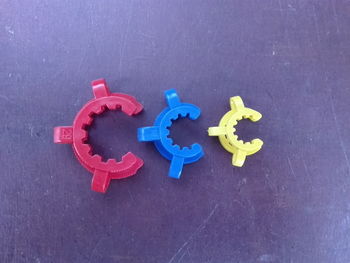Difference between revisions of "Keck clip"
| Line 1: | Line 1: | ||
{{Stub}} | {{Stub}} | ||
| − | [[File:Keck clips plastic polyacetal.jpg|thumb|350px|Polyacetal plastic keck clips, in | + | [[File:Keck clips plastic polyacetal.jpg|thumb|350px|Polyacetal plastic keck clips, in 29/32, 19/26 and 14/23 sizes]] |
'''Keck clips''' also known as '''keck clamps''', '''joint clips''', or often just '''kecks''', are fastening devices used to hold ground glass joints glassware when assembling lab set-ups ([[reflux]], [[distillation]], [[sublimation]], [[Schlenk line]]s, etc.). They are available in plastic and metal forms. | '''Keck clips''' also known as '''keck clamps''', '''joint clips''', or often just '''kecks''', are fastening devices used to hold ground glass joints glassware when assembling lab set-ups ([[reflux]], [[distillation]], [[sublimation]], [[Schlenk line]]s, etc.). They are available in plastic and metal forms. | ||
Latest revision as of 20:06, 16 November 2020
 |
This article is a stub. Please help Sciencemadness Wiki by expanding it, adding pictures, and improving existing text.
|
Keck clips also known as keck clamps, joint clips, or often just kecks, are fastening devices used to hold ground glass joints glassware when assembling lab set-ups (reflux, distillation, sublimation, Schlenk lines, etc.). They are available in plastic and metal forms.
Contents
General
Keck clips come in two forms: plastic and metal:
- Plastic keck clips: have the appearance of two stacked cogwheels, one larger than the other, connected with three joints. They are commonly made of polyacetal (polyoxymethylene or POM). Polyacetal melts at around 175 °C and begins to soften around 140 °C. As glassware temperatures are recommended up to 250 °C, care needs to be taken that clips made from this material are not being used to hold glass together that will get this hot. Typical problem areas include a flask over the plate (which may drop off the end of the column as it gets hot) and the condenser-still head connection (which will reach high temperatures and may allow the condenser to fall off). As such, different clips should be used at these points or the glassware should be clamped such that these elements can't slide apart or don't need the clip. Plastic joint clips are individually colored based on their size, which allows for easier identification. The coloring is not universal, some manufacturers will use different sets of colors for different sizes. PTFE is also used for joint clips, and can handle high temperatures much better than POM (excellent performance up until 250 °C) and are chemically inert to all solvents. PTFE joint clips have a different design than the classical keck clip, they are much thicker, have a double "C" shape with a flat extension from their middle, have a sealed-in steel spring and are numbered with joint size for easy identification. Main disadvantages of PTFE joint clips are poor mechanical properties, low resistance to wear, limited availability and are very expensive.
- Metal keck clips: come in two varieties: one type has the appearance of two "C"-shaped metal strips with rounded ends connected via three metal strips of the same alloy; the other type consists of an Ω-shaped elastic thick metal wire, which forms two C-shaped sections, one large and one small. This type is commonly referred to as wire clip. Metal joint clips are commonly made of stainless steel or some chromium-nickel steel alloy, which display excellent thermal and chemical resistance to solvents. Halogens and some acids will corrode metal kecks. Main disadvantage of metal joint clips is that they tend to scratch the glass after repeated use. To limit this, you can coat the metal clips with Plasti Dip or bedliner and repeat the procedure after the protective coating starts to wear off.
Availability
Keck clips can be bought from lab suppliers.
Maintenance
Plastic kecks will weaken over time if exposed to high temperatures and corrosive temperatures. They are susceptible to cracking. Plastic keck clamps should never be washed with base or acid baths.
Metal keck clamps resist high temperatures, but can be severely attacked by halogens and various acids. Biggest problem with metal clamps is that they will slowly scratch the glass around the joints over repeated uses, and there is a risk of snapping the glass is weakened enough. While metal kecks can be washed in a base bath, this is not required. Never use acid to wash them.
